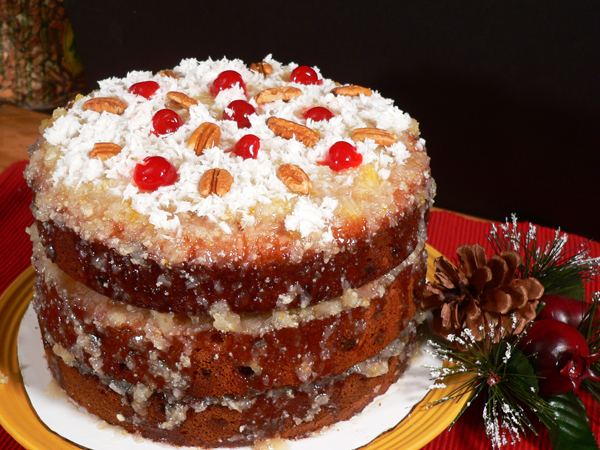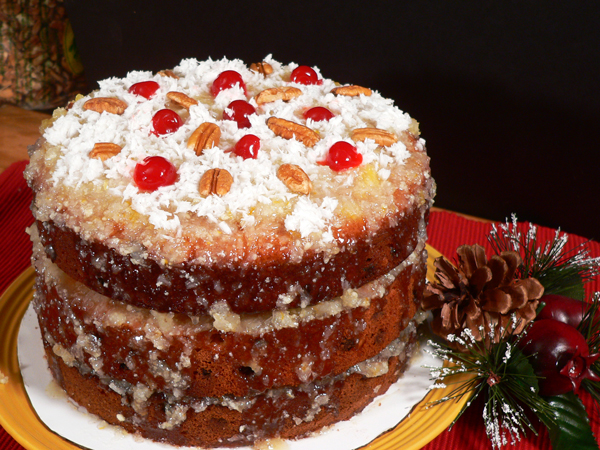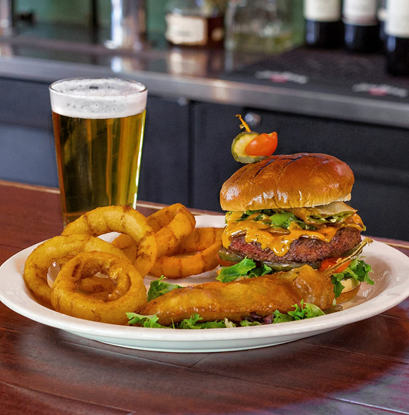
Follow our complete, step-by-step, photo illustrated instructions to make this Southern favorite known as a Japanese Fruitcake. This old fashioned Christmas cake contains raisins in a spice flavored cake with a coconut and orange filling. Printable recipe included.

Japanese Fruitcake recipe
The weeks before Thanksgiving, up through Christmas were my Mama’s “time to shine.” She loved to cook, and she loved to share what she cooked, and baked, with family and with friends.
Dishes and baked goods we never saw at any other time of the year found themselves in Mama’s kitchen and on her tables throughout the holidays. I’m sure she was tired, after all she worked a full time job during the day, but always seemed to enjoy being in the kitchen afterwards.
I’m blessed to be able to remember Daddy, sitting at the kitchen table cracking open fresh coconuts, and removing the brown skins from the white flesh of the coconut so Mama could grate it down for her cakes and pies.
We spent most of our time in the kitchen and dining room area. They had heat. The fireplace in the living room didn’t generally have a fire in it except on weekends when company was expected. A small electric heater was in the bathroom in later years, but the bedrooms never did have heat. Just saying.
The kitchen cabinet, the one with the glass doors, would all at one time hold one of Mama’s Coconut Cakes, a Japanese Fruit Cake, maybe an Orange Slice Cake, and a couple of pies. And, let’s not forget the Icebox Fruitcake that was in the refrigerator.
It was definitely getting really close to Christmas Day when that happened.
Mama made Christmas special, in more ways than one. Wait, why are my eyes watering now?
I’m not sure, and haven’t been able to find, any real definition of why this is called a Japanese Fruitcake, it just is. Mama always seemed to bake one each Christmas as I recall.
This is another recipe from our family reunion cookbook that the family created years back. Members of the family submitted some of their favorite recipes, and the cookbook was created and sold for several years at our family reunions. Called the “Stewart Family Favorites,” this recipe for the Japanese Fruit Cake was submitted by Aunt Iva.
Often referred to as “Aunt Iver” (EYE-ver) our Southern speak changed her name a bit.
This version of the cake was submitted by her as one of her favorites. You’ll find various versions of this cake if you search around a bit. I think it was more dependent on what each family liked and/or could afford when they made one.
The layers have a spice cake flavor. It’s only fruit inside the layers are raisins. It doesn’t have an actual frosting, using a “filling” instead. The filling is made with oranges and coconut, and has a bright tropical type of flavor. Maybe the tropical flavors were suppose to make the long, hard and cold winters back then easier to cope with.
I do hope you’ll try our recipe, and I look forward to reading your comments and memories about the cake if you’d like to share them.
Ready to give our Japanese Fruitcake a try? Alright then, let’s head to the kitchen, and… Let’s Get Cooking!

Japanese Fruit Cake, you’ll need these ingredients to make the cake layers.

Japanese Fruitcake filling: You’ll need these ingredients to make the filling for the cake.
You can substitute whole milk for the canned milk if you prefer.

We’ll begin by sifting enough flour to make the layers for the cake.
You’ll need 4 level cups of sifted flour. Always sift the flour first, then measure.

Crack the eggs.
I always suggest that you crack the eggs in a small separate bowl. That way, if any eggshell falls in, you’ll be able to see it and easily remove it.

Grab a large mixing bowl and add the two sticks of softened butter. The butter needs to be at room temperature to begin making the batter for the cake.
Add the sugar.

Using a mixer on a lower speed, cream the butter and sugar together until smooth.
I set a timer to do this by. It just doesn’t happen in a couple of minutes. I set my timer for eight minutes and just hang on until the butter and sugar begin to look more like a frosting. It takes a little time and effort, but it makes a difference.

Add the eggs one at a time.

Mix the eggs into the batter just until they are combined. Do not over mix.
Repeat this process until you have added all four eggs, scraping down the sides of the bowl as needed.

Prepare the raisins.
Place the raisins in a mixing bowl, then add a couple of Tablespoons of flour to the raisins. Stir this together until the raisins are coated with flour. Set this aside for now.

Remember to always measure out flour in level cupfuls.
We’ll add the flour in small portions at a time, alternating adding the flour and the milk until we have mixed it all into the batter.

Mix the flour until combined. Do not over mix.

Add about one third cup of the milk at a time.
Mix the milk into the batter until it’s combined. Do not over mix.
Repeat this process until you have added all the milk and all the flour. You’ll do this in segments as follows, always starting with flour and ending with flour.
- One cup flour
- 1/3 cup milk
- One cup flour
- 1/3 cup milk
- One cup flour
- 1/3 cup milk
- One cup flour
Just mix each addition until its combined, scraping down the sides of the bowl as needed.

Add the cocoa.

Add the ground allspice.

Add the cinnamon.

Add the vanilla extract.

Mix the spices and vanilla into the batter just until combined.
Add the raisins.

Grab a large spoon and gently fold the raisins into the batter.

Prepare your baking pans.
I used a spray type oil that contains flour to lightly spray the bottoms of my 8 inch pans. Then, I added the parchment paper circles that I had cut out and lightly sprayed the tops of the paper.
You could also just lightly grease and flour the pans if you prefer.

Divide the batter as evenly as possible between the pans.
Use the back of your spoon to gently spread the batter evenly out in the pans. If you’re using parchment paper in the bottoms of your pans, you have to be extra careful when trying to spread the batter. It just wants to slide the paper instead of moving the batter. Take it slowly and you can spread it out.
Once filled, I lift each pan up off the counter about 6 or 8 inches high, then just drop it down onto the counter. This helps release any air bubbles that might be in the batter. Besides, it’s fun. Smile

Place the pans on the middle rack in your oven that has been preheated to 350F degrees.
I placed all three pans in my oven at one time, placing one pan in the middle and at the back of the oven, with the other two towards the front.
After about 20 minutes, I rotated the pans, pulling the one in back to the front and pushing the ones in front to the back, switching them around from one side to the other at the same time so they would bake more evenly.

Test your cake layers to be sure they are done by inserting a wooden toothpick into the center of the layer. If it pulls out fairly clean, without big crumbs hanging on, the layer is done. Remove it from the oven and place it on a wire rack to cool.
If the toothpick pulls out with crumbs attached, then let the layer bake for a few minutes longer until it will pass the toothpick test.

Prepare the filling;
When you’re ready to assemble your cake, start by preparing the filling. Scrape the zest off of one of the oranges, with a microplane if you have one. You could also use a paring knife to cut very thin layers of the outer skin off the orange, then chop the skin up very fine.
Don’t cut down into the white -pith- layer of the orange. It’s very bitter and you don’t want to use that part.

Take a sharp knife and slice away the pith part of the orange. Just discard this white part.

Cut the oranges into segments, making sure you save all the juice. Basically I just squeezed the pulp part of the orange out from between the tougher part that holds the segments together. I didn’t want that tough part in the finished pulp and juice.
I did this to BOTH oranges, but again, I only used the zest from one.

Place the milk in a medium sized sauce pot, over medium heat on your stove top.
Please note that I did not use the Evaporated Milk as pictured in the ingredients photo for making the filling. I used whole milk instead. I did use the Evaporated Milk in the layers though. Just saying.

Add the sugar.

Add the orange juice, zest, and pieces of orange to the milk and sugar.

Add the thawed coconut.
I used almost two bags of coconut, reserving just about 1/4 cup to garnish off the top layer.

You’ll need to keep stirring this as it comes up to a light boil.
Let it boil at a low simmer, stirring often, for SEVEN MINUTES.
Be sure to scrape all the way down to the bottom, so it doesn’t burn or stick.

Mix and add the cornstarch.
Mix the cornstarch along with about 1/4 cup COLD water, until the cornstarch has dissolved into the water. Add this “slurry” to the coconut mixture, stirring constantly.
The filling should thicken a little, but it will not get real thick.
Let it simmer for about four minutes longer, then remove it from the stove top. You also need to go ahead and empty this mixture into another bowl so it can cool quicker.

Remove the layers from their pans by first running a thin bladed knife around the inside of the pan to loosen the layer.
Place the wire rack on top of the layer in the pan. Holding the pan and rack together, flip it all over. The layer should easily fall from the inside of the pan.

If your layers have a large dome in the center, as often happens, you might want to use a large bread knife to level the tops of the layers. Just slide the blade through the layer, removing the high domed center of the layer.
I only did this with one layer, the other two turned out fairly flat on top.

I’m going to place this cake on a cake board. I’ve placed the board on a cake turntable to help in adding the filling. You could just place it directly on a cake plate if you prefer. Your choice.
I always add just a spoonful or two of frosting to the center of the board or plate before adding the fist layer. This helps keep the layer centered and from sliding around while you’re working with it.

Position the first layer on the board.

I forgot to poke some holes in the layer before adding the filling, but did it after the filling was on the layer. Use a wooden skewer to poke holes into the layer so the filling can sink down into the layer.
The filling is a bit runny, so just spread it to the outer edge of the layer.

Center the second layer on top of the first. Poke holes in the second layer.

Spread the filling over the top of the second layer. As you can see, it easily runs off the sides. Not to worry, we’ll clean it up once we finish.

Add the third cake layer. Center it up to the bottom two, then cover it with the filling. Let a little run down the sides, then wipe your plate or board clean.
I added the little bit of coconut that I had reserved to the top, then added some Marashino Cherries and pecan pieces to the top to try and decorate it a bit.
I certainly don’t claim to be a cake decorator type of person, I guess that’s fairly obvious. Still, the cake certainly has that homemade look, don’t you think? Smile.
Let the cake sit for a few hours prior to slicing and serving… if you can wait that long.
Enjoy!
PS: Here are some other recipes here on Taste of Southern you might find of interest.



